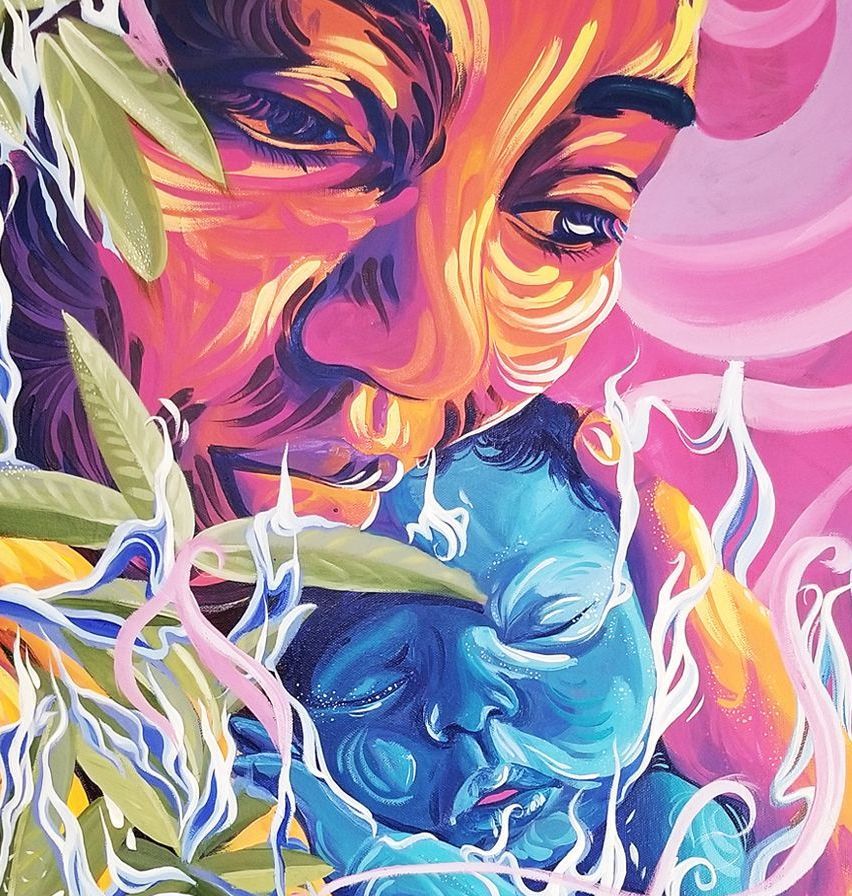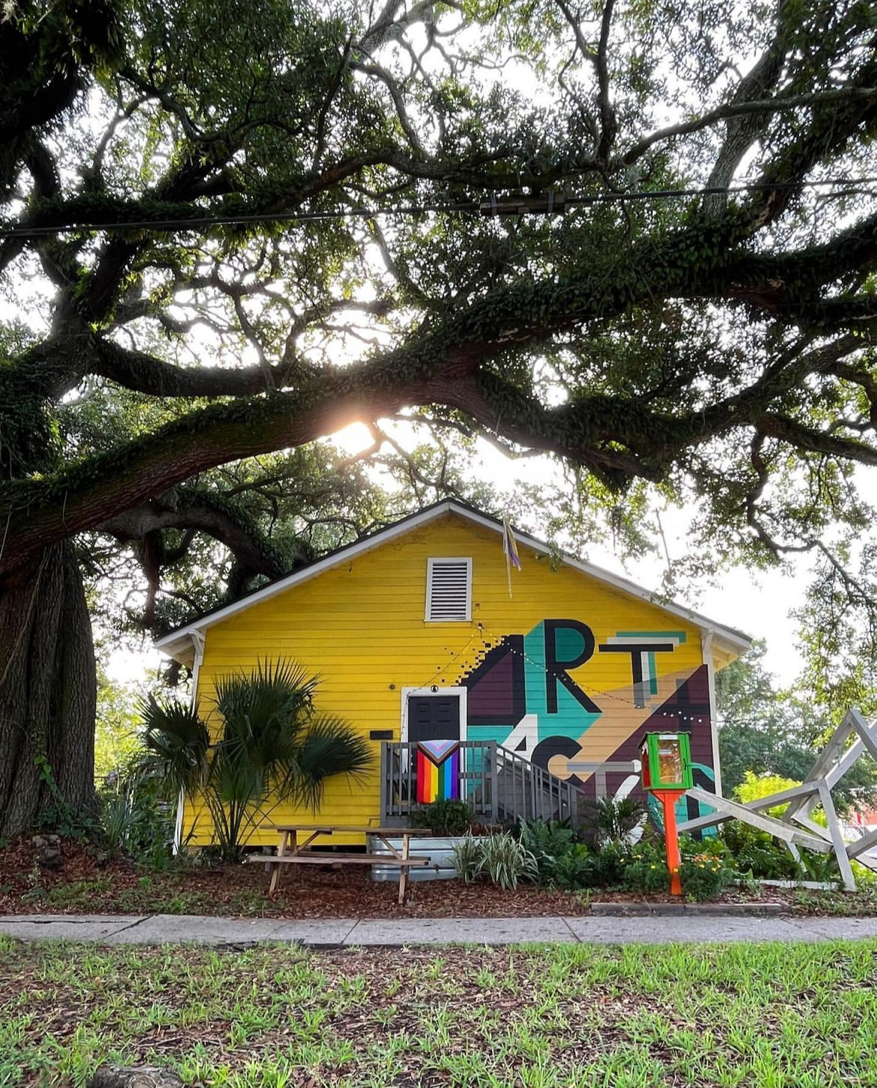YELLOW HOUSE
JACKSONVILLE, FL
WE-Making is a suite of resources that explores the relationship between place-based arts practices and social cohesion to advance health equity and community wellbeing. This We-Making story demonstrates how place-based arts and cultural strategies uniquely contributed to social cohesion and wellbeing in this community. Throughout this story you’ll see terms paired with actions in parentheses (e.g., social capital, collective action, place attachment, civic engagement, self-determination of shared values). This denotes for the reader how the WE-Making framework was specifically incorporated. Explore the WE-Making framework and resources.
The walls inside the small, bright yellow house are covered with art by local artists with faces that represent the diversity of the city. Families paint signs to take down town to a march for human rights. A small gathering of folks sits on a picnic table on the front lawn, sharing and devouring fresh fruit from the Community Cart as conversation moves from introductions to origin stories. A family walks by and gathers up books from the small library under the large oak tree. Small works of art in the form of recipe cards are exchanged while a group of young activists plot their next action to remove Confederate monuments from the public square. Heavy sighs and laughter combine in an intimate weaving of respite and resistance, curiosity and community care, creativity and connection.
Yellow House was founded as a place where art, truth-telling, mutual aid and activism come together, not during an occasional event or program, but each and every day (place attachment- reason for participation in arts and culture activities). Artists, poets, neighbors, youth voices, and community advocates have co-created a gracious and courageous space centered around the shared beliefs that the arts are vital to a more socially connected, cohesive and just world (collective efficacy- community ownership); where artists are key partners in societal progress; and, where art making is essential to well-being, especially when it leaves its pedestal and becomes part of daily life(collective efficacy- consistent presence in the community). Inclusivity, access, collaboration and the practice of intentional listening and shared learning are embedded in the work - work that takes on that which is challenging while also being steeped in joy.
Jacksonville, Florida is a city of one million people, spread out over a whopping 874 square miles, that still grapples with a history of racial division, overshadowed by a remarkable diversity in all sectors of its society. Once referred to as the ‘Harlem of the South’, the city was a hub for Black creatives that shone bright during Reconstruction, and played an important role in the Civil Rights Movement. Jacksonville has since seen the attempted (and sometimes successful) erasure of Black communities, the isolation of immigrant neighborhoods, and the continued reverence to the Confederate South.
Yellow House is located at one of the many intersections in Jacksonville - between communities that have been historically divided by race, economics, and the segregated legacy of interstates and redlining. Yellow House attempts to bridge differences and cultivate fertile ground for collective action, while providing a space for reflecting on our histories and reimagining a future where all community members can thrive (creative responses to trauma and racism).
Artists create experiences in the space that provide a vessel for conversations and organizing around issues that are important to the communities that surround Yellow House. Exhibitions have given voice to concerns ranging from environmental justice and gender liberation to the legacy of racism and refugee experiences. Voting rights, Black motherhood, the power of protest, simple joys, the life giving that is water, and uplifting youth voices have all taken their place (social capital- bonding). But these exhibitions are more than collections of art on the walls; they serve as invitations to share stories, transfer wisdom across groups of people, and provide fuel for collective action.



An exhibition on the history of lynching in North Florida became a place for remembrance, the honoring of victims through a community altar, the speaking of truths hidden for decades, healing circles, and public actions (celebration and preservation of culture). Another exhibition asked artists and community members to reflect on what it means to be well, and the link between personal wellness and the state of society. Beyond being beautiful and powerful artistically, the ‘Be Well ’exhibition became a platform for sharing information about vaccinations, activating community members around food justice, and engaging healthcare providers in efforts to address health inequities.
Although art is core to the Yellow House mission, so are concepts of solidarity, sanctuary, healing, and sustenance. During the pandemic lockdown, access to food, especially fresh food, was a serious issue. And, in a neighborhood impacted by historic redlining, stymied by still a food desert, these challenges were exponentially more serious. Artists, activists, students and volunteers began working once a week at an area farm, trading labor for a carload of fresh produce. This trade-off gave birth to the Community Care Cart, a mutual aid space, that stands openly on the front lawn of Yellow House. Every day of the week, this artful space receives and distributes produce, hygiene items, art supplies, recipe cards, books, period products, and information on voting rights, mobile health clinics, and hurricane preparedness (creative responses to trauma and racism). It is a place where neighbors care for and connect to neighbors, where people take what they need and leave what they can (social capital- bonding). And this creative, no-cash exchange happens every day. This caring cooperative is an attempt to address real needs, in real ways, using the gifts, skills, and resources at hand. It is a hyper-local recognition of our common humanity and the needs we each have that can be met through aid, activism, education, and radical love — even on a humble scale (civic engagement- willingness to participate, orientation toward the common good).
Art also occurs outside the walls through community-based, people-driven actions. The Community Tree is one of such actions. It builds on indigenous practices of creating healing spaces in an outdoor environment, where many hands create a single, powerful artful experience. Anyone can take ribbons from the mutual aid space, add their messages, and tie them onto the tree (collective action- community participation designed to facilitate dialogue and lead to deeper engagement). Inspired by a purposefully commissioned poem, also displayed on the exterior of Yellow House entitled “Shadow and Shine”, people of all ages,from around the city and near and far, lift up their messages of grief and hope, anger and joy, loss and progress. Even when COVID-19 caused us to be physically separated, the conversation continued in the branches of a mighty oak in the center of the neighborhood, elevating a sacred space that already held much history in the stories of the generations who lived before (celebration and preservation of culture).
how arts and culture moved the dial in Jacksonville...
How did these examples of place-based arts and cultural struggles help Jacksonville, or at least one corner of a large place, realize community well-being? Jacksonville struggles with a long history of segregation, disenfranchisement and erasure. Yellow House is a hub for collaboration, convening and connection, because it is an anchor for sustained efforts to give space to elevate stories of Black, immigrant, LGBTQ+, and young people. More than 180 artists, poets and activists have been able to speak their truths and engage in building social cohesion through their work. People from a wide variety of sectors have linked arms to address racial inequity, motivate people to go to the polls, counter false information during the pandemic, engage with elected officials, demand removal of racist symbols in public parks, and celebrate the brilliance of living in a diverse city. All of this is being done with community care at the center, recognizing that too many lack resources and have been marginalized by policies and practices that remain all too prevalent.
place-based arts and cultural strategies…
Hope McMath, Phyllis Bell-Davis, and a small, mighty team of fellows, interns, and volunteers co-create every experience with neighbors, educators, artists, activists, and partners. Daily programs, as well as special programs, bring together people across differences to create a community focused on healing, celebration, truth-telling, and taking action. Although time and resources are given over to the goal of reckoning with trauma, there is a strong focus on lifting up possibilities of justice, liberation, free expression, and equity. Community input, ongoing engagement, and acknowledgement of our distinctly different experiences, alongside our common humanity, allow us to build and share power. This leads to direct action with those in positions of control, and provides a model of mutual aid based on alternative ways of living, supporting, and caring. Yellow House is not an event or monthly program, but a place that has a consistent presence - the community’s living room, studio, commons, or front porch.
amplify the drivers of social cohesion…
At Yellow House, seeing others and being seen for who we are, the history we hold, and the dreams that need to be spun out into the world, become ties that bind us to one another and to a specific place. Breaking bread over a simple meal, sharing stories of who we are and want to be, connecting causes in order to advocate for each other's well being, making art together, and fostering relationships across race, age, gender, and culture, bring social cohesion. When farmers, writers, painters, musicians, mothers, students, anti-racism activists, and the families down the street come together regularly, with art as the invitation, the definition of ‘neighbor’ becomes expansive.
At Yellow House, it looks like people are in meaningful dialogue with a work of art, while others are setting type in the print studio to create a message they want the world to see. It looks like people are not only adding a ribbon to the Community Tree, but also reading the messages left by previous visitors to the outdoor space. It looks like folks bringing banned books to distribute to young people in the neighborhood and neighbors bringing the surplus oranges from their backyard tree that they want to share with strangers. It looks like Black women artists exploring their roles as leaders, mothers, victims, fighters, lovers, and caregivers. It looks like a poet from Syria sharing a meal with an activist from Iraq planning an exhibition with a white woman from Jacksonville making space for inquisitive young people who were initially stopping in to hang out in a place that feels safe. It looks like a young artist from Vietnam showing her work for the first time in a show alongside a well-known elder, and the birth of an unbreakable bond. It looks like peaches that become currency, art that lifts the veil of silence, a space that can hold peacekeepers and agitators. It looks like an organization - a community - that is transparent, authentic, messy, and evolving.
to increase equitable community well-being...
One small yellow building open to all, does not reverse historic inequities in a neighborhood that still feels divided - even when the geographic separation is no more than a couple blocks. It is a space that becomes a living illustration of what cohesion can look like, what belonging feels like, and what freedom might taste like. Yellow House shows, through collective action, that art is for everyone, that access to fresh food is a basic right, that artists are our greatest truth-tellers, that creativity’s a necessary ingredient for solving systemic problems, that our histories can’t be erased, and that we can care give and give care simultaneously



